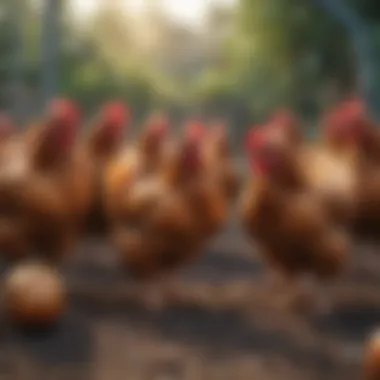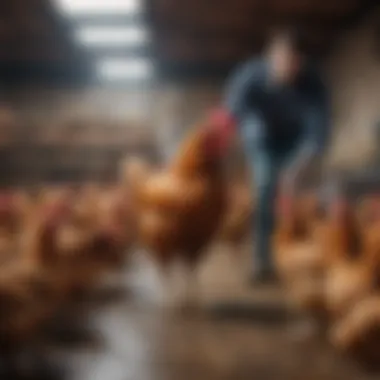Essential Steps for Establishing a Successful Chicken Rearing Venture


Animal Species Profile
Chicken rearing, often considered a gateway into the world of poultry farming, can be a rewarding venture for aspiring entrepreneurs. This section focuses on the introductory aspects of chickens, diving into their physical characteristics, behavior, and more.
Introduction to the Animal Species
Chickens, scientifically known as Gallus gallus domesticus, are domesticated birds widely raised for their meat and eggs. These avian creatures belong to the Phasianidae family, with various breeds showcasing distinct features and purposes, ranging from meat production to ornamental traits. Understanding the essence of chicken breeds and their functional roles is fundamental before embarking on a poultry farming journey.
Physical Characteristics and Appearance
Chickens exhibit a diverse range of colors, feather patterns, and sizes based on their breed. From sleek and slender bodies to plump frames, chickens showcase a spectrum of physical diversity. They sport beaks adapted to pecking and scratching, talons for perching, and feather-covered bodies for insulation. Observing and appreciating the multifaceted physical attributes of chickens enhances an individual's poultry farming acumen.
Natural Habitat and Distribution
While chickens are domesticated animals, their lineage traces back to wild junglefowl of Southeast Asia. In their natural habitat, chickens foraged for food and nested in secure areas. Understanding the evolutionary progression of chickens aids in creating conducive environments that align with their innate instincts and behaviors in a rearing setup.
Behavior and Social Interactions
Chickens, surprisingly sociable creatures, exhibit complex social hierarchies within flocks. Pecking orders, vocalizations, and communal activities characterize their social dynamics. Studying chicken behavior sheds light on their communication nuances, forging a deeper connection between poultry farmers and their avian companions. Developing insight into chicken social structures is paramount for fostering a harmonious and thriving chicken rearing venture.
Understanding the Basics of Chicken Rearing
Chicken rearing serves as a fundamental aspect of poultry farming, demanding a comprehensive grasp of essential practices and procedures. From selecting the right breeds to complying with local regulations, every decision propels the success and sustainability of a chicken rearing venture. Understanding the basics of chicken rearing provides a sturdy foundation for novice poultry farmers, ensuring efficient operations and optimal outcomes.
Importance of Researching Before Starting
Embarking on a chicken rearing journey necessitates meticulous research to pave the path for a thriving enterprise. By delving into key areas such as identifying goals and objectives, aspiring poultry farmers can strategically outline their mission and vision for the venture. Choosing the right chicken breeds is a critical facet of poultry farming, influencing factors like productivity and adaptability to specific environments. Comprehending local regulations ensures legal compliance and fosters a harmonious relationship with authorities, essential for the seamless operation of the venture.


Identifying Goals and Objectives
Delineating clear goals and objectives is paramount in the realm of chicken rearing, guiding farmers towards sustainable practices and profitable outcomes. By setting definitive targets, poultry farmers can align their efforts with overarching strategies, enhancing operational efficiency and financial viability. The process of identifying goals and objectives enables prudent decision-making, facilitating a structured approach to rearing chickens that aligns with long-term aspirations.
Choosing the Right Chicken Breeds
The selection of appropriate chicken breeds underscores the success of a poultry operation, influencing aspects such as egg production, meat quality, and resistance to diseases. By choosing breeds that resonate with the farm's objectives and environmental conditions, farmers can optimize productivity and minimize risks. Each breed carries distinct characteristics, necessitating a thorough evaluation to match the specific requirements and goals of the rearing venture.
Understanding Local Regulations
Navigating local regulations is a foundational step in ensuring the legality and sustainability of a chicken rearing venture. By understanding and adhering to regulatory frameworks, farmers can mitigate potential conflicts, uphold animal welfare standards, and foster positive relationships within the community. Compliance with local guidelines promotes responsible farming practices and cultivates a positive reputation for the venture.
Establishing a Suitable Rearing Space
Creating an appropriate rearing space sets the stage for a productive and safe environment for the chickens. Factors such as space requirements, safety measures, and ventilation systems play a pivotal role in (continues)
Setting Up Feed and Water Management Systems
In the realm of poultry farming, setting up feed and water management systems plays a critical role in ensuring the well-being and productivity of the chicken population. The pivotal role of proper nutrition and hydration cannot be overstated when delving into the complexities of raising chickens. By carefully configuring efficient systems for feeding and watering, poultry farmers lay a solid foundation for the overall success of their venture. Adequate nourishment and hydration are fundamental requirements for maintaining the health and performance of chickens. Attention to detail in designing these systems can translate into higher egg production rates, healthier birds, and ultimately, a flourishing chicken rearing operation.
Developing a Feeding Schedule
Balanced Nutrition Requirements
Developing a feeding schedule that incorporates balanced nutrition requirements is paramount for optimizing the growth and vitality of chickens. In this article, emphasis is placed on the meticulous balance of essential nutrients like proteins, vitamins, and minerals in the chicken diet. Achieving the right blend of nutrients ensures robust growth, optimal egg formation, and overall well-being of the flock. The unique feature of balanced nutrition requirements lies in its ability to support both physical development and disease resistance in chickens, making it a preferred choice for those seeking sustainable poultry farming practices.
Meal Planning and Management
Meal planning and management are integral components of a well-rounded feeding schedule for chickens. The efficient organization of meals not only regulates food consumption but also promotes healthier eating habits among the flock. This article accentuates the importance of structured meal planning to prevent overfeeding or undernourishment. One key characteristic of meal planning and management is its capacity to streamline feeding operations, reducing wastage and promoting cost-effective practices. While offering convenience and efficiency, proper meal planning enhances the nutritional intake of chickens, bolstering their overall health.


Food Storage Practices
Effective food storage practices are instrumental in maintaining the quality and safety of chicken feed. Proper storage methods safeguard feed from contaminants and ensure its freshness and nutritional value. This article sheds light on the significance of meticulous food storage to prevent spoilage and contamination. The unique feature of food storage practices lies in their ability to extend the shelf life of feed while preserving its essential nutrients. By adhering to recommended storage guidelines, poultry farmers can optimize feed efficiency and uphold the health standards of their flock.
Ensuring Adequate Water Supply
Water Quality Considerations
Ensuring that chickens have access to clean and uncontaminated water is essential for their hydration and well-being. Addressing water quality considerations involves monitoring factors such as purity, pH levels, and pathogen content in the drinking water. This article underscores the importance of providing chickens with high-quality water to promote optimal health and performance. The unique feature of water quality considerations is their direct impact on the overall hydration and immune resilience of the flock, making it a crucial factor in poultry management practices.
Accessibility and Cleanliness
The accessibility and cleanliness of water sources are key factors in guaranteeing adequate hydration for chickens. Maintaining clean waterers and ensuring easy access to water play a pivotal role in sustaining the hydration levels of the flock. This article highlights the significance of regular cleaning and monitoring of water sources to prevent contamination and dehydration issues. One key characteristic of accessibility and cleanliness is their contribution to preventing waterborne diseases and enhancing the overall health of the chickens. By prioritizing these aspects, poultry farmers can significantly boost the well-being and performance of their flock.
Monitoring Hydration Levels
Monitoring hydration levels is a proactive measure to track the water consumption patterns of chickens and identify potential health issues early on. This article emphasizes the importance of observing and regulating the hydration levels of the flock to prevent dehydration-related complications. The unique feature of monitoring hydration levels lies in its capacity to detect illnesses or stress factors that may affect the water intake of chickens. By incorporating regular hydration monitoring into their management practices, poultry farmers can ensure the vitality and resilience of their flock, thereby fostering a thriving chicken rearing environment.
Maintaining Health and Hygiene Standards
In the context of starting a chicken rearing venture, maintaining health and hygiene standards emerges as a pivotal factor crucial to the success of the operation. Proper health practices ensure the well-being of the flock, reducing the risk of diseases and thereby improving productivity. Implementing robust health and hygiene standards involves a multi-faceted approach that encompasses various aspects such as vaccination protocols, biosecurity practices, and regular health checks. By focusing on these elements, poultry farmers can safeguard their livestock and optimize the overall efficiency of their venture.
Implementing Disease Prevention Measures
Vaccination Protocols
Vaccination protocols play an integral role in safeguarding poultry health and preventing the spread of contagious diseases within a flock. By adhering to specific vaccination schedules tailored to the prevalent diseases in the region, farmers can significantly reduce the risk of outbreaks. The key characteristic of vaccination protocols lies in their proactive nature, offering preemptive protection against known poultry ailments. This approach is particularly advantageous for this article as it underscores the importance of disease prevention in poultry farming. Despite their effectiveness, vaccination protocols may present disadvantages such as potential side effects in some chickens, which should be carefully monitored.
Biosecurity Practices


Biosecurity practices constitute a set of measures aimed at preventing the introduction and spread of diseases in poultry populations. The main characteristic of biosecurity practices is their role in fortifying the farm against external pathogens, thus maintaining a secure environment for the flock. This approach is popular for its proactive nature, minimizing the risk of disease transmission. A unique feature of biosecurity practices is their adaptability to various farm settings, offering tailored solutions to different poultry operations. While advantageous in disease prevention, biosecurity practices require stringent implementation and consistent monitoring.
Regular Health Checks
Incorporating regular health checks into the routine management of a poultry operation is essential for early disease detection and prompt intervention. The key characteristic of regular health checks is their role in providing timely insights into the well-being of the flock, enabling farmers to address any potential health issues expediently. This approach is popular among poultry farmers for its effectiveness in maintaining flock health and performance. A unique feature of regular health checks is their contribution to proactive disease management, supporting overall herd health. However, a potential disadvantage of regular health checks may be the associated costs and time commitment, which need to be weighed against the benefits.
Ensuring Cleanliness and Waste Management
Sanitation Procedures
Effective sanitation procedures form the cornerstone of maintaining cleanliness and hygiene in a poultry operation. By establishing thorough sanitation protocols for coop cleaning, equipment sterilization, and waste disposal, farmers can mitigate disease risks and create a healthy environment for their flock. The key characteristic of sanitation procedures lies in their ability to reduce microbial contamination and enhance biosecurity on the farm. This makes them a beneficial choice for enhancing overall hygiene standards in poultry rearing. However, one must be cautious of potential drawbacks, such as the need for regular maintenance and diligence in adherence to sanitation practices.
Composting Strategies
Composting strategies offer a sustainable solution for managing poultry waste by converting it into nutrient-rich compost for use in agriculture. The key characteristic of composting strategies is their environmental benefit, helping to reduce waste disposal and recycle organic matter. This eco-friendly approach aligns with the ethos of sustainable farming promoted in this article. A unique feature of composting strategies is their dual function of waste management and soil enrichment, contributing to farm productivity and environmental conservation. While advantageous in promoting recycling and resource efficiency, composting strategies may require initial setup costs and ongoing monitoring to ensure optimal composting conditions.
Managing Odors and Pests
Effectively managing odors and pests is integral to maintaining a hygienic and comfortable environment for poultry. By adopting odor control measures and implementing pest management strategies, farmers can alleviate nuisances and prevent potential health hazards for the flock. The key characteristic of managing odors and pests is their impact on improving air quality and reducing disease vectors on the farm. This makes them a popular choice for enhancing the overall welfare of poultry. A unique feature of these strategies is their holistic approach to environmental management, addressing both olfactory concerns and pest control simultaneously. Despite their benefits, managing odors and pests may require ongoing diligence and periodic reviews to ensure sustained effectiveness and farm hygiene.
Monitoring Performance and Growth
In the realm of chicken rearing, monitoring performance and growth plays a pivotal role in ensuring the success and health of your poultry operation. By closely observing how your chickens are faring, you can make informed decisions to optimize productivity and address any potential issues promptly. Monitoring includes tracking various aspects such as egg production, feather condition, and behavioral patterns. Through consistent monitoring, you can detect patterns, recognize abnormalities early, and enhance overall efficiency.
Tracking Productivity and Behavior
Understanding how to track productivity and behavior in your flock is crucial for gauging the success of your chicken rearing venture. By monitoring productivity indicators like egg production, you can assess the health and well-being of your chickens. Observing behavioral patterns allows you to identify stressors or health issues, promoting a proactive approach to poultry care.
- Egg Production Monitoring: Egg production monitoring is a vital aspect of tracking productivity in chicken farming. It provides valuable insights into the reproductive health of your hens and the overall performance of your flock. By consistently recording and analyzing egg production rates, you can adjust feeding schedules, identify potential health issues, and boost overall efficiency.
- Feather Condition Assessment: Evaluating feather condition is essential in poultry management. Healthy feathers are indicative of good overall health in chickens. By regularly assessing the quality of feathers, you can spot signs of malnutrition, disease, or stress. Maintaining optimal feather health contributes to improved insulation, protection, and overall welfare of your birds.
- Behavioral Observations: Monitoring behavioral patterns in chickens offers valuable information on their well-being and environmental adaptation. By observing behaviors like feeding habits, social interactions, and activity levels, you can detect early signs of disease, stress, or discomfort. Understanding chicken behavior aids in creating a conducive environment and addressing any welfare concerns promptly.
Evaluating Economic Viability
Assessing the economic viability of your chicken rearing venture is essential for long-term sustainability and success. By evaluating costs, revenue streams, and return on investment (ROI), you can make informed decisions to optimize profitability and growth.
- Cost Analysis of Inputs: Conducting a detailed cost analysis of inputs such as feed, medication, housing, and labor helps in understanding the financial requirements of your poultry operation. By tracking expenses and identifying cost-saving opportunities, you can streamline your budget, maximize efficiency, and ensure financial stability.
- Revenue Generation Strategies: Developing effective revenue generation strategies is key to sustaining your chicken rearing business. Explore avenues like selling eggs, meat, or breeding stock, as well as value-added products to diversify income streams. Implementing marketing tactics, exploring new markets, and optimizing pricing structures can bolster your revenue generation efforts.
- ROI Calculation: Calculating the return on investment (ROI) enables you to measure the profitability of your poultry venture. By analyzing the ratio of net profit to the initial investment, you can determine the efficiency and profitability of your business operations. ROI calculations help in evaluating performance, identifying areas for improvement, and making informed strategic decisions for future growth.







